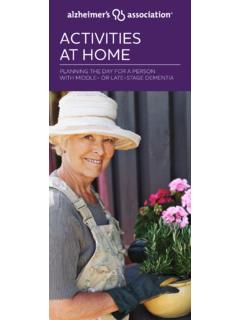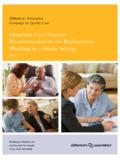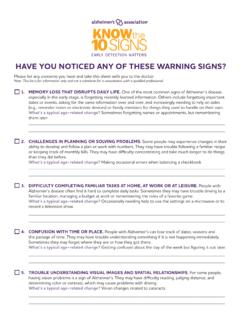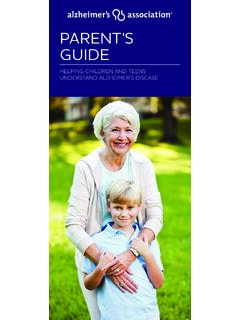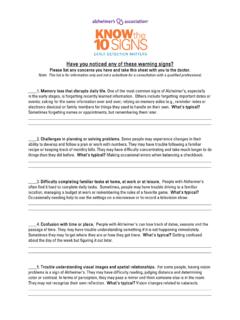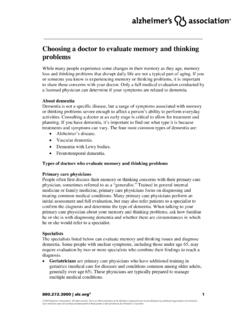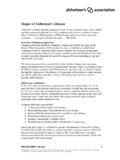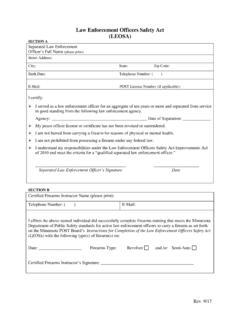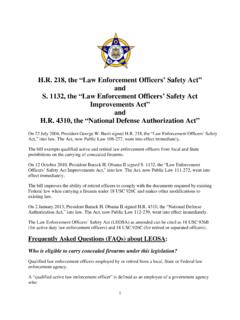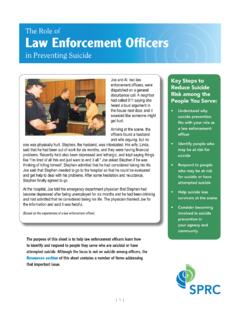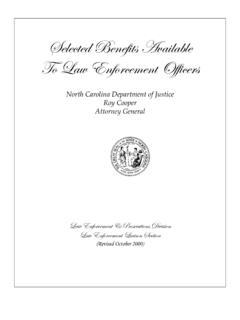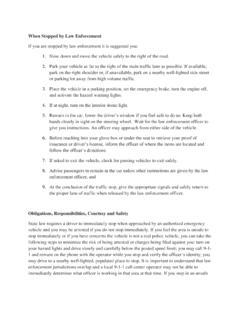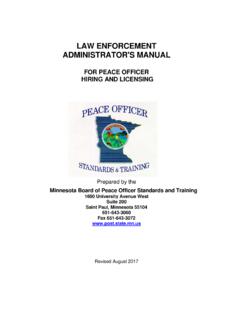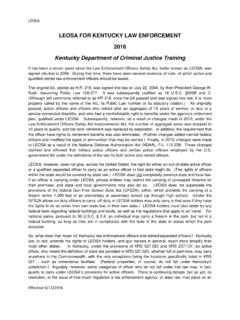Transcription of Alzheimer’s disease Guide for law enforcement
1 alzheimer s diseaseGuide for law enforcementWhen you encounter a person who has wandered, check for a bracelet, pendant, key chain, wallet card or clothing label that bears the person s Safe Return ID number and the emergency enforcement and alzheimer s diseaseAs our population ages, the number of people with alzheimer s continues to grow as does the likelihood that you will come in contact with an individual with the disease in your this Guide to become more familiar with the unique aspects of alzheimer s disease and the best ways to recognize, communicate with and respond to a person with alzheimer s is pronounced AHLZ-high-merzWhat is alzheimer s disease ? alzheimer s disease is a progressive brain disorder that gradually destroys a person s memory and ability to learn, reason, make judgments, communicate and carry out daily activities.
2 As alzheimer s progresses, individuals may also experience changes in personal-ity and behavior, such as anxiety, suspiciousness or agitation, as well as delusions or hallucinations. alzheimer s is the most common form of dementia, a group of conditions that gradually destroys brain cells and leads to progressive decline in mental out of 10 people with alzheimer s will s disease causes millions of people in the United States to lose their ability to recognize familiar places and faces or to even remember their names or addresses. They may become disoriented and lost, even in their own neighborhood. They may wander by foot as well as by car or other form of transporta-tion. Although common, wandering can be dangerous if not found within 24 hours, up to half of those who wander risk serious injury or death. Inclement weather, busy roads and landscape trouble spots pose a greater risk to the wandering individual.
3 The alzheimer s Association works with law enforcement to help save lives through its Safe Return program. Safe Return can helpThe alzheimer s Association Safe Return program is a 24-hour nationwide identification, support and enrollment program. We work with law enforcement to quickly identify and return to safety a person with alzheimer s or a related dementia who has wandered, locally or far from encounters with people with alzheimer sWandering is just one situation you are likely to encounter with an individual with alzheimer s disease . Many behaviors associated with dementia tend to increase a person s chance of interacting with law enforcement . Because these individuals are often unable to explain their unusual behavior, their actions are more easily accidentsBecause of memory impairment and alterations in perception, a person with dementia may fail to obey street signs, traffic lights or speed limits.
4 If the person is involved in an accident, he or she may even flee the scene, unaware of personal injuries or property drivingThe symptoms of alzheimer s disease may cause a person to drive erratically. Though the individual may appear intoxicated by failing to yield or obey traffic signals, the officer may assess that no signs of alcohol or drug use are present. In this case, dementia may provide an reports and victimizationWhile people with dementia easily fall prey to con artists, sometimes when a person with alzheimer s has lost or misplaced an item, he or she may call 911 to report a theft. In many cases, reports of a burglary- in-progress or a strange intruder turn out to be an otherwise familiar family member or even a spouse whom the person with dementia has exposureA person with dementia may completely forget the societal norms associated with dress and impulse control.
5 In addition, repetitive behavior exhibited by people with dementia, such as fidgeting with zippers or buttons, may be misinterpreted as deviant behav-ior. Because judgment is often impaired, undressing in public or leaving the house without proper attire occur impairment can hinder the ability to remember to pay for items. People with dementia may walk out of stores without paying, unaware of any wrongdoing. Confronting the person is not recommended. Instead, ease the person out of the situation, and try to resolve the matter with the store manager and caregiver. Suicide and homicideCaregivers may feel deeply hopeless when faced with the increasingly exhaustive needs of caring for a person with dementia. Some caregivers may feel so stuck that death seems the only solution. Caregivers may also be threatened when the person with dementia mistakenly believes the caregiver is an intruder.
6 For those with dementia, the presence of a weapon may lead to unexpected danger. A firearm can be found in 6 out of 10 homes that have a family member with dementia and percent of those homes reported that the gun was loaded according to a 1999 warning signs of alzheimer s Memory loss Difficulty performing familiar tasks Problems with language Disorientation to time and place Poor or decreased judgment Problems with abstract thinking Misplacing things Changes in mood or behavior Changes in personality Loss of initiativeFacts about alzheimer sDid you know? One in 10 people over age 65 and nearly half over age 85 have alzheimer s disease . About 88 percent of those enrolled in Safe Return are found within 24 hours.* For those not enrolled in the program, only 25 percent were found within 24 hours, according to one study.
7 Immediate response to a wandering incident helps save lives. If not found within 24 hours, up to half of those who wander risk serious injury or death. *According to statistics acquired since members of your community to the alzheimer s Association for more informationThe alzheimer s Association is the leading donor-supported, voluntary health organization in alzheimer research, care and support. Our mission is to eliminate alzheimer s disease through the advancement of research; to provide and enhance care and support for all affected; and to reduce the risk of dementia through the promotion of brain s disease Quick response tips If you encounter someone showing signs of alzheimer s disease , the person may seem uncooperative with no memory of what happened, despite easily verifiable events. Because alzheimer s disease affects the part of the brain where memory is stored, the individual may be unable to answer your questions or understand the seriousness of the incident.
8 When you encounter a person with dementia Identify yourself as a law enforcement officer , and explain why you ve approached the person. Maintain good eye contact. Speak slowly in a non-threatening, low-pitched voice. Loudness can convey anger; do not assume the person is hearing-impaired. Use short, simple words. Ask yes and no questions. Ask one question at a time, allowing plenty of time for response. If necessary, repeat your question using the exact wording. People with dementia may only grasp a part of the question at a time. Instead of speaking, try non-verbal communication. Prompting with action works well. Maintain a calm environment, devoid of chaos and excessive stimuli; reduce radio volume, keep squelch down and avoid use of sirens. Avoid restraints; confinement may trigger agitation, which may compound confusion and disorientation.
9 Restraints should be used only as a last resort for the safety of the individual or others. Avoid confrontation. Avoid correcting or reality checks. If possible, use another individual to communicate if dialog seems stalled, but be sure that only one person speaks at a reliable information and support, contact the alzheimer s s disease Quick response tips When a person with dementia is reported missing Respond to the incident as an emergency begin search-and-rescue efforts immediately. Search the immediate vicinity 94 percent are found within miles of where they disappeared. Look around landscape trouble spots, like ponds, tree lines or fence lines; 29 percent are found within brush or briar. Use information from previous wandering episodes or other repetitive patterns to point to the most likely destinations; consider areas of the individual s past jobs or homes.
10 Use media broadcasts, when approved by family. Contact Safe Return through the incident line at assistance with a wandering incident, Safe Return sign-up and other services, or visit members of your community to enrollin alzheimer s Association Safe Return 2006 alzheimer s Association, Inc. All rights under grant number 2005-SJ-BX-K160 from the Office of Juvenile Justice and Delinquency Prevention, Office of Justice Programs, Department of is an official publication of the alzheimer s Association but may be distributed by unaffiliated organizations and individuals. Such distribution does not constitute an endorsement of these parties or their activities by the alzheimer s s AssociationSafety Services225 N. Michigan Avenue, Fl. 17 Chicago, IL
